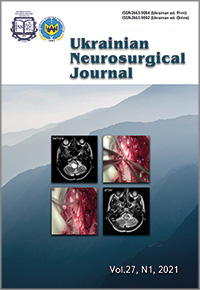Morphological characteristic of intracerebral hemorrhage in rats and correlation of its volume with results of behavioral tests
DOI:
https://doi.org/10.25305/unj.221282Keywords:
intracerebral hemorrhage, rats, behavioral tests, morphometryAbstract
The intracerebral hemorrhage is associated with severe complications and high mortality. Currently there are no effective methods of treatment of this disease while the standard collagenase model of intracerebral hemorrhage is not described sufficiently.
Objective. To analyze morphological characteristics of the collagenase model of intracerebral hemorrhage, and develop the regression formula predicting the hemorrhage volume based on the results of behavioral tests.
Materials and methods. The experiments were carried out on 7 white male rats weighing 250-400 g aged 11-13 months. All animals underwent surgery to simulate intracerebral hemorrhage. Rats were anesthetized and then, stereotactically, using a needle with a diameter of 0.47 mm, 0.2 units of collagenase type IV were slowly injected into the left striatum. The day after the intracerebral hemorrhage, functional disabilities developed in rats were studied using beam walking test, neurological score test and adhesive removal test. Immediately after performing behavioral tests, the rats were sacrificed by decapitation. After the brain formalin fixation, serial sections on a vibromicrotome of 200 µm thick each in the anteroposterior direction with following morphological examination were made.
Results. It was revealed that the collagenase model of intracerebral hemorrhage is associated with a large variability of the hemorrhage volume. It also had an irregular rugged shape and marks of repeated diapedetic hemorrhages of about 0.6 mm depth. The center of intracerebral hemorrhage along the anteroposterior axis was in average 0.5 mm posterior of the actual site of collagenase injection.
The combined use of the neurological score test, the beam walking test and the adhesive removal test in the collagenase model can help estimate the probable intracerebral hemorrhage volume on the 1st day using the regression formula.
Conclusions. Technical details identified in our study can help researchers in planning and conduction of correct experiments related to intracerebral hemorrhage.
References
1. An SJ, Kim TJ, Yoon BW. Epidemiology, Risk Factors, and Clinical Features of Intracerebral Hemorrhage: An Update. J Stroke. 2017 Jan;19(1):3-10. [CrossRef] [PubMed] [PubMed Central]
2. Godoy DA, Núñez-Patiño RA, Zorrilla-Vaca A, Ziai WC, Hemphill JC. Intracranial Hypertension After Spontaneous Intracerebral Hemorrhage: A Systematic Review and Meta-analysis of Prevalence and Mortality Rate. Neurocrit Care. 2019 Aug;31(1):176-87. [CrossRef] [PubMed]
3. Fiorella D, Zuckerman SL, Khan IS, Ganesh Kumar N, Mocco J. Intracerebral Hemorrhage: A Common and Devastating Disease in Need of Better Treatment. World Neurosurg. 2015 Oct;84(4):1136-41. [CrossRef] [PubMed]
4. MacLellan CL, Silasi G, Poon CC, Edmundson CL, Buist R, Peeling J, Colbourne F. Intracerebral hemorrhage models in rat: comparing collagenase to blood infusion. J Cereb Blood Flow Metab. 2008 Mar;28(3):516-25. [CrossRef] [PubMed]
5. Sang YH, Liang YX, Liu LG, Ellis-Behnke RG, Wu WT, So KF, Cheung RT. Rat model of intracerebral hemorrhage permitting hematoma aspiration plus intralesional injection. Exp Anim. 2013;62(1):63-9. [CrossRef] [PubMed]
6. Paxions G, Watson C. The rat brain in stereotaxic coordinates: Compact. 7th ed. Sydney: Academic Press; 2017. 388p.
7. Beray-Berthat V, Delifer C, Besson VC, Girgis H, Coqueran B, Plotkine M, Marchand-Leroux C, Margaill I. Long-term histological and behavioural characterisation of a collagenase-induced model of intracerebral haemorrhage in rats. J Neurosci Methods. 2010 Aug 30;191(2):180-90. [CrossRef] [PubMed]
8. Urakawa S, Hida H, Masuda T, Misumi S, Kim TS, Nishino H. Environmental enrichment brings a beneficial effect on beam walking and enhances the migration of doublecortin-positive cells following striatal lesions in rats. Neuroscience. 2007 Feb 9;144(3):920-33. [CrossRef] [PubMed]
9. Ross MH. Histology: a text and atlas with correlated cell and molecular biology. 7th ed. 2016. 984 p.
10. Kvitnitskaia-Ryzhkova TYu, Bozhok YuM, editors. Introduction to quantitative histology. Kiev: Kniga-plus; 2013. 256 p. Russian.
11. Artamentova LO, Utevska OM. Statistics for biologists. Kharkiv: HTMT; 2014. 331 p. Ukrainian.
12. McDonald JH. Handbook of biological statistics. Baltimore: Sparky House Publishing; 2014. 299 p.
13. Perry LA, Rodrigues M, Al-Shahi Salman R, Samarasekera N. Incident cerebral microbleeds after intracerebral hemorrhage. Stroke. 2019 Aug;50(8):2227-2230. [CrossRef] [PubMed]
14. Tao Y, Tang J, Chen Q, Guo J, Li L, Yang L, Feng H, Zhu G, Chen Z. Cannabinoid CB2 receptor stimulation attenuates brain edema and neurological deficits in a germinal matrix hemorrhage rat model. Brain Res. 2015 Mar 30;1602:127-35. [CrossRef] [PubMed]
15. Kitaoka T, Hua Y, Xi G, Hoff JT, Keep RF. Delayed argatroban treatment reduces edema in a rat model of intracerebral hemorrhage. Stroke. 2002 Dec;33(12):3012-8. [CrossRef] [PubMed]
16. Klahr AC, Dietrich K, Dickson CT, Colbourne F. Prolonged Localized Mild Hypothermia Does Not Affect Seizure Activity After Intracerebral Hemorrhage in Rats. Ther Hypothermia Temp Manag. 2016 Mar;6(1):40-7. [CrossRef] [PubMed]
17. Klahr AC, Dickson CT, Colbourne F. Seizure activity occurs in the collagenase but not the blood infusion model of striatal hemorrhagic stroke in rats. Transl Stroke Res. 2015 Feb;6(1):29-38. [CrossRef] [PubMed] [PubMed Central]
Downloads
Published
How to Cite
Issue
Section
License
Copyright (c) 2021 Kyrylo M. Zolotko, Oleksandr M. Sukach, Antonina M. Kompaniiets, Kateryna S. Liubomudrova

This work is licensed under a Creative Commons Attribution 4.0 International License.
Ukrainian Neurosurgical Journal abides by the CREATIVE COMMONS copyright rights and permissions for open access journals.
Authors, who are published in this Journal, agree to the following conditions:
1. The authors reserve the right to authorship of the work and pass the first publication right of this work to the Journal under the terms of Creative Commons Attribution License, which allows others to freely distribute the published research with the obligatory reference to the authors of the original work and the first publication of the work in this Journal.
2. The authors have the right to conclude separate supplement agreements that relate to non-exclusive work distribution in the form of which it has been published by the Journal (for example, to upload the work to the online storage of the Journal or publish it as part of a monograph), provided that the reference to the first publication of the work in this Journal is included.









